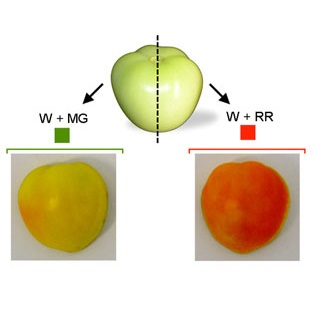2015/12/17
Carotenoids are isoprenoid pigments essential for plants because they protect the photosynthetic apparatus against excess light and also function as health-promoting natural pigments that provide color to ripe fruit, promoting seed dispersal by animals. When sunlight passes through the flesh of green tomatoes, these ripe and turn red due to an increase of carotenoid levels. This is possible thanks to chlorophyll breakdown and degradation of Phytochrome-Interacting-Factor (PIFs), which are in charge of modulating carotenoid biosynthesis.
In order to fully understand the process of ripening in fruit and the behavior of the carotenoid gene expression in response to environmental signals, CRAG- Centre For Research In Agricultural Genomics- researchers teamed up with the ICFO researchers Dr. Jordi Andilla and Dr. Pablo Loza, head of the SLN Facility, to study this process. The main idea was to probe the actual biological behavior in the most natural conditions by using photonics.
To do this, the ICFO team measured the spectral transmittance (quantity) of climate controlled grown green and red tomatoes. By slicing it and uniformly removing micrometer-layers they determined the ratio between red and far infrared absorption (quality) produced in each micro-layer of the tomato.
The results they obtained from this work have proven the mechanism to be a success, stating a new way or method of probing the inside of fruits to determine the biosynthesis process in their ripening progression.
Link to the paper
Link to the SLN facility led by Dr. Pablo Loza

Photonics and Tomatoes
The SLN facility at ICFO collaborates with CRAG to analyze the ripening process of tomatoes.

Photonics and Tomatoes













